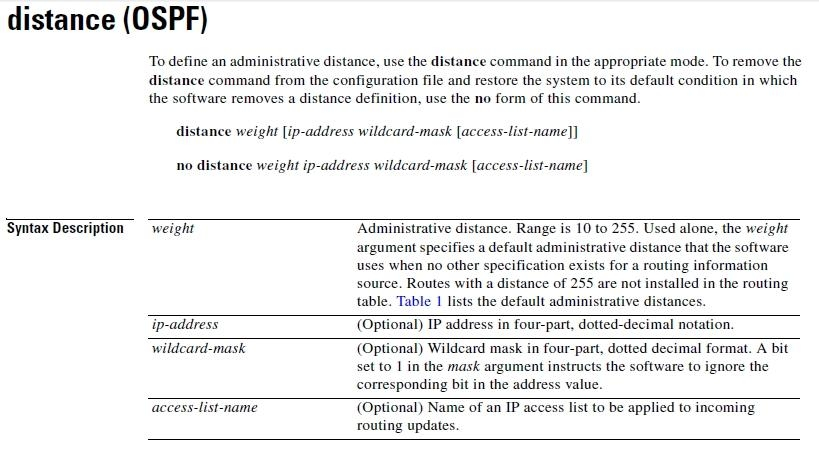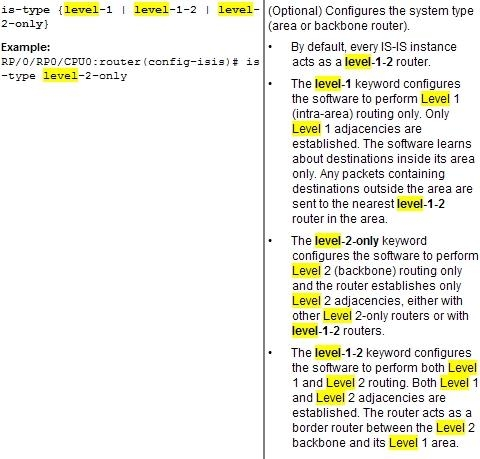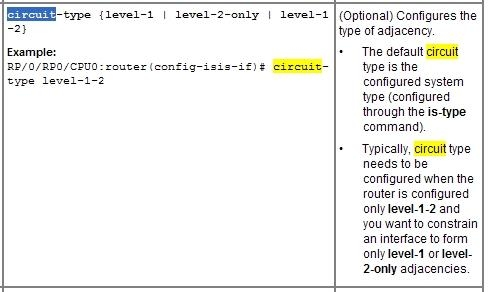Cisco® 642-883 Exam Practice Questions (P. 2)
- Full Access (191 questions)
- Six months of Premium Access
- Access to one million comments
- Seamless ChatGPT Integration
- Ability to download PDF files
- Anki Flashcard files for revision
- No Captcha & No AdSense
- Advanced Exam Configuration
Question #6
What is function of the RP/0/RSP0/CPU0:PE1(config-ospf)#distance Cisco IOS-XR command?
- ATo modify the administrative distance of the OSPF routes
- BTo modify the default seed metric of the OSPF external routes
- CTo modify the OSPF default reference bandwidth
- DTo modify the OSPF cost
Correct Answer:
A
http://www.cisco.com/en/US/docs/ios_xr_sw/iosxr_r3.8/routing/command/reference/rr38ospf.pdf

A
http://www.cisco.com/en/US/docs/ios_xr_sw/iosxr_r3.8/routing/command/reference/rr38ospf.pdf

send
light_mode
delete
Question #7
Which four statements are correct regarding IS-IS operations? (Choose four.)
- ABy default, Level 1 routers within an IS-IS area do not carry any routing information external to the area towhich they belong. They use a default route to exit the area.
- BSummarization should be configured on the Level 2 routers, which injects the Level 2 routes into Level 1.
- CIS-IS supports "route leaking" in which selected Level 2 routes can be advertisedby a Level 1/Level 2 router into Level 1.
- DThe IS-IS backbone is a contiguous collection of Level 1 capable routers, each of which can be in a different area.
- EWith IS-IS, an individual router is in only one area, and the border between areas is on thelink that connects two routers that are in different areas.
- FCisco IOS XR Software supports multitopology for IPv6 IS-IS unless single topology is explicitly configured in IPv6 address-family configuration mode.
Correct Answer:
ACEF
http://www.cisco.com/en/US/docs/ios_xr_sw/iosxr_r3.0/routing/configuration/guide/rc3isis.html#wp1148617
Single-Topology IPv6 Support -
Single-topology IPv6 support on Cisco IOS XR software allows IS-IS for IPv6 to be configured on interfaces along with an IPv4 network protocol. All interfaces must be configured with the identical set of network protocols and all routers in the IS-IS area (for Level 1 routing) or the domain (for Level 2 routing) must support the identical set of network layer protocols on allinterfaces.
When single-topology support for IPv6 is used, only narrow link metrics, also known as old-style type, length, value (TLV) arguments, may be employed. During single-topology operation, one shortest path first (SPF) computation per level is used to compute both IPv4 and IPv6 routes. Using a single SPF is possible because both IPv4 IS-IS and IPv6 IS-IS routing protocols share a common link topology.
Because multitopology is the default behavior in the software, you must explicitly configure IPv6to use the same topology as IPv4 in order to enable single- topology IPv6. Configure the single-topology command in ipv6 address family configuration submode of the IS-IS router stanza.
Multitopology IPv6 Support -
Multitopology IPv6 support on Cisco IOS XRsoftware differs from Cisco IOS software in that IS-IS assumes that multitopology support is required as soon as it detects interfaces configured for both IPv6 and IPv4 within the IS-IS stanza.
You must use the metric-style wide command to configure IS-ISto wide link metrics as multitopology link advertisements.
ACEF
http://www.cisco.com/en/US/docs/ios_xr_sw/iosxr_r3.0/routing/configuration/guide/rc3isis.html#wp1148617
Single-Topology IPv6 Support -
Single-topology IPv6 support on Cisco IOS XR software allows IS-IS for IPv6 to be configured on interfaces along with an IPv4 network protocol. All interfaces must be configured with the identical set of network protocols and all routers in the IS-IS area (for Level 1 routing) or the domain (for Level 2 routing) must support the identical set of network layer protocols on allinterfaces.
When single-topology support for IPv6 is used, only narrow link metrics, also known as old-style type, length, value (TLV) arguments, may be employed. During single-topology operation, one shortest path first (SPF) computation per level is used to compute both IPv4 and IPv6 routes. Using a single SPF is possible because both IPv4 IS-IS and IPv6 IS-IS routing protocols share a common link topology.
Because multitopology is the default behavior in the software, you must explicitly configure IPv6to use the same topology as IPv4 in order to enable single- topology IPv6. Configure the single-topology command in ipv6 address family configuration submode of the IS-IS router stanza.
Multitopology IPv6 Support -
Multitopology IPv6 support on Cisco IOS XRsoftware differs from Cisco IOS software in that IS-IS assumes that multitopology support is required as soon as it detects interfaces configured for both IPv6 and IPv4 within the IS-IS stanza.
You must use the metric-style wide command to configure IS-ISto wide link metrics as multitopology link advertisements.
send
light_mode
delete
Question #8
When configuring IPv4 and IPv6 IS-IS routing on Cisco IOS XR routers, which three statements are correct? (Choose three.)
- ABy default, a single SPF is used for both IPv4 and IPv6, so the IPv4 and IPv6 topology should be the same.
- BBy default, the IS-IS router type is Level 1 and Level 2.
- CAll IS-IS routers within the same IS-IS area must be configured with the same IS-IS routing process instance ID.
- DBy default,metric-style narrow is used.
- EBy default, the IS-IS interface circuit type is Level 1 and Level 2.
- FThe area IS-IS address-family configuration command is used to specify the IS-IS area address.
Correct Answer:
BDE

The default metric style for single topology is narrow metrics. However, you can use either wide metrics or narrow metrics. How to configure them depends upon how single-topology is configured. If both IPv4 and IPv6 are enabled and single-topology is configured, the metric style is configured in the address-family ipv4 stanza. You may configure the metric style in the address-family ipv6 stanza, but it will be ignored in this case. If IPv6 only is enabled and single topology is configured, then the metric style is configured in the address-family ipv6 stanza.

BDE

The default metric style for single topology is narrow metrics. However, you can use either wide metrics or narrow metrics. How to configure them depends upon how single-topology is configured. If both IPv4 and IPv6 are enabled and single-topology is configured, the metric style is configured in the address-family ipv4 stanza. You may configure the metric style in the address-family ipv6 stanza, but it will be ignored in this case. If IPv6 only is enabled and single topology is configured, then the metric style is configured in the address-family ipv6 stanza.

send
light_mode
delete
Question #9
Refer to the PE1 router routing table output exhibit.

What is causing the i su 10.1.10.0/24 [115/30] via 0.0.0.0, 00:40:34, Null0 entry on the PE1 router routing table?

What is causing the i su 10.1.10.0/24 [115/30] via 0.0.0.0, 00:40:34, Null0 entry on the PE1 router routing table?
- AThe PE1 router is receiving the 10.1.10.0/24 summary route from the upstream L1/L2 IS-IS router.
- BThe PE1 router has been configured to summarize the 10.1.10.x/32 IS-IS routes to 10.1.10.0/24.
- CThe 10.1.10.0/24 has been suppressed because IS-IS auto-summary has been disabled on the PE1 router.
- DThe 10.1.10.0/24 has been suppressed because of a route policy configuration on the PE1 router.
- EThe 10.1.10.0/24 has been suppressed because the more specific 10.1.10.x/32 IS-IS routes have been configured to leak into the IS-IS non-backbone area.
Correct Answer:
B

B

send
light_mode
delete
Question #10
In comparing IS-IS with OSPF, a Level-1-2 IS-IS router is similar to which kind of OSPF router?
- AASBR on a normal OSPF area
- BASBR on NSSA
- CABR on totally stubby OSPF area
- DABR on stubbyOSPF area
- EABR on a normal OSPF area
Correct Answer:
C
C
send
light_mode
delete
All Pages
